A Brief History of Male/Female Relations
Men and women, are we really so different? To help us understand sex, gender, and our whole place within this species, I’ve put together a brief timeline of how men and women have come to relate to each other. Think of it as a highlight reel of the last billion years. Enjoy.

1.2 Billion Years Ago – Sex evolves in single-cell organisms. One eukaryotic cell would approach another eukaryotic cell and tickle its membrane. If the other eukaryote tickled back, then they would open their nuclei, swap chromosomes, smoke a cigarette, and promise to call each other next weekend.
Sex evolved because combining the DNA of two organisms promoted better genetic fitness than one organism’s DNA replicating itself over and over (a.k.a., genetic masturbation). As a result, sexual reproduction occurs in almost every multi-celled organism that we know of. And while there are many species of plant and fungi that have multiple sexes, almost every animal species has ended up with one male and one female.
125 Million Years Ago – Early mammals appear. Attachment and basic emotions such as love, happiness, anger and sadness emerge. Body hair becomes all the rage.
66 Million Years Ago – Asteroid hits the earth. Dinosaurs go extinct. Dating pool gets thinner.
55 Million Years Ago – The first primates emerge.
22 Million Years Ago – The great apes evolve. Sexual dimorphism (the physical differences between males and females) evolve differently in each ape. Gorillas exhibit large sexual dimorphism with extremely large and powerful males and small and weak females, implying large biological differences between each sex. Chimpanzees and humans exhibit slight dimorphism implying only slight biological differences between each sex. Sexual dimorphism is important because the greater the dimorphism, the greater the difference in sexual behavior between males and females on average.

200 Thousand Years Ago – The first humans appear in Africa. They live as small bands of hunter-gatherer tribes consisting of 10-50 people each. While men tend to do more of the hunting and women more of the gathering, both sexes are equally indispensable to the survival of each community. It’s suspected by many anthropologists that these were egalitarian communities where men and women were treated quite fairly and various forms of promiscuity and polygamy were not only accepted, but sometimes encouraged.
Over thousands of years, homo sapiens fanned out across the planet and these sexual mores would change and adapt to environmental surroundings based on region and culture. In more dangerous environments with scarce resources, men’s strength and size would become disproportionately valuable and societies would become more patriarchal, granting more polygamous rights to men but not to women. In safer environments with abundant resources, men’s comparable size and strength would become less economical and these societies would become more egalitarian and sexually promiscuous.
It’s during these millennia that the biological bases of gender and sexual behavior evolved. And a lot has been made of it. It seems clear that there are both slight and significant psychological differences between men and women, but which differences and how significant they are is still up for major debate.
But it is pretty conclusive that there are major differences between men and women in two areas: physical aggression and sexual arousal. Men are more physically aggressive, more physically energetic and more tactile. Men also have more consistent but less flexible sexualities. They are more aroused through visual stimulation. Women are less physically aggressive and have better verbal skills. They have less consistent but more flexible sexualities. They are more aroused through psychological stimulation.
150 Thousand Years Ago – Spoken language invented. Men and women can finally communicate their thoughts and desires to one another. Women take advantage of the opportunity to tell men everything they’ve been feeling for the past 50 thousand years. Men pretend to listen even though they’re not.
40 Thousand Years Ago – Humans begin to paint, sculpt and make art. Pornography is promptly invented.
7,000 BC – Agriculture is discovered. For the first time in human history, humans are able to accumulate surpluses of food and resources far beyond the capacity of one person to consume. This means that the people who are best at farming or have the best land, gain a huge economic advantage over the rest of the population. Socio-economic inequality emerges. Class systems begin to take hold. Humanity will never be the same.
5,000 BC – Agriculture slowly marginalizes women in society. The best farmers are required to work with heavy tools and large animals for long periods of time. Men have a major advantage farming due to their greater size and strength. Pregnant women can’t work at all. Women’s economic contribution to a functioning society plummets and as a result they become subservient to the men they’re with.
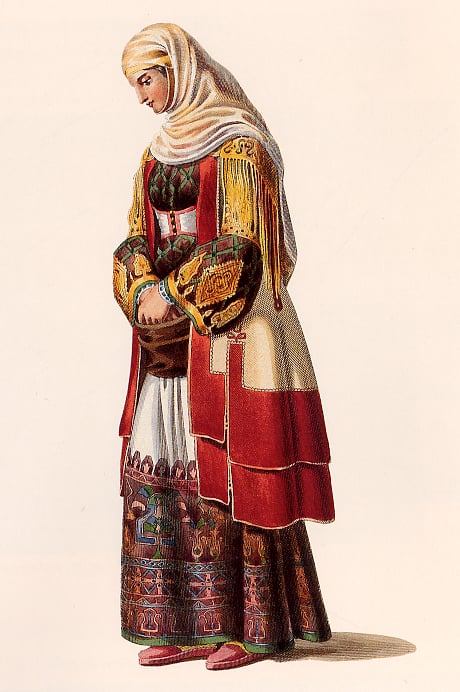
2,000 BC – The earliest city/states emerge in Mesopotamia and northern Africa and later on in India and China. City/states usher in thousands of years of imperial conquests beginning with the Sumerians and stretching all the way through the Romans and Mongols to the British Empire almost 4,000 years later.
Marriage is now the primary unit of economic organization in the city/state systems. As men struggle to accumulate land, resources and power, they need to guarantee paternity of their children so that they may pass their wealth on to their own kin (subsistence hunter-gatherer societies seemed to lack this preoccupation). As a result, female chastity and submissiveness becomes necessary in women to appeal to powerful men on the dating market. Female sexuality is objectified and fertility is a woman’s only economically viable option for social improvement.
As a result, women’s lives are, quite literally, traded on the open market between a woman’s family and the eligible bachelors of similar or higher social standing. More powerful men even take on multiple women as wives or create harems for themselves. Divorces and remarriages become rampant as men shuffle between women’s families looking for the best option to move them ahead. Meanwhile, families vie to marry off their girls to create political alliances and gain access to more resources and wealth. There is very little romance involved. Sex is a duty more than a pleasure. Women possess few personal rights and are entirely dependent on the men in their families for their needs. Many girls are often married to husbands who are old and cruel. This practice of social arrangement would continue for the majority of human history and it persists in many parts of the world today.
30 AD – Jesus shows up. Doesn’t treat women like shit. Declares marriage sacred. Says a man and wife should be bound together forever. This was a novel idea at the time. (Spoiler Alert: He dies.)
380 AD – Christianity spreads quickly throughout the Roman Empire. The empire is wide and highly diverse at this time. Christianity appeals to many citizens because it shows no bias towards ethnicity and provides an easy, one-size-fits-all social model to a wide variety of cultures. In the year 380 it is declared the official religion of the Roman Empire. Many of the more naughty pagan sexual practices (harems, orgies, etc.) aren’t considered cool anymore. Thanks Jesus…
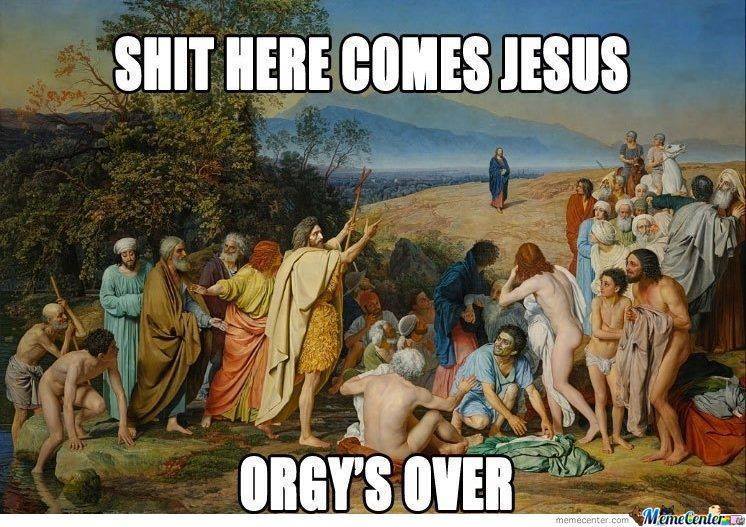
476 AD – The Roman Empire collapses. Europe is left in disarray. The Catholic Church becomes the only stable political entity with a broad reach.
800 AD – Charlemagne is crowned Holy Roman Emperor on Christmas Day by Pope Leo III. To consolidate their power over the dozens of vying kingdoms on the continent, Charlemagne and Leo institute the Catholic Church’s newer, stricter rules on marriage: no polygamy, no divorce, no remarrying, no marrying members of one’s own family, and illegitimate children cannot inherit.
Although implemented under moral auspices, these rules have political aims. Europe was covered by dozens of tiny kingdoms and fiefdoms, all vying to consolidate their political power through alliances, marriages and outright war. By removing the nobility’s right to marry more than one woman, the right to divorce, and the right for illegitimate sons to inherit land, Charlemagne effectively limited any other king’s ability to consolidate his power and threaten him or his heirs ever again. It would be more than 500 years before a European kingdom would consolidate enough power to challenge the supremacy of the Church.
These new rules would trickle down into the culture and develop the classic “until death do us part” and “happily ever after” romantic narratives that we’re all so familiar with today.
1394 AD – The earliest known book of relationship advice for women is published in France. It urges women to do everything their husbands say and to not be so horny all the time. During the medieval age, women are considered the more sexual sex. Women were seen as temptresses and immoral at best, evil at worst. Sexual morality was pretty clear-cut in the middle ages: celibacy or die. Adulterers, both men and women, were publicly tortured and murdered in hideous ways. As a result, domestic violence was the norm and could often become deadly.
Gone was the promiscuity of the ancient civilizations. Medieval marriages were arranged for practical purposes. As in ancient times, life was difficult during these centuries and women were necessary to work within the home and maintain order. The Catholic Church’s marriage laws granted women more power and individuality than in ancient times or in other regions of the world. But a man’s wife was still more an employee than a life-partner.
1533 AD – Henry VIII of England invents his own church so he can get rid of his wife Catherine. In all, he marries six times, divorcing or killing four of them. The Anglican Church, along with Martin Luther’s reformation, loosens the Catholic Church’s monopoly on marriage.
1596 AD – Toilet seat invented. Arguments ensue.
1689 AD – Enlightenment philosopher John Locke states that women are equal to men and should be given equal rights. Everyone just pretends like they didn’t hear what he said.
1790 AD – The industrial revolution brings more economic opportunity to more men in Europe than ever before. Many men can now make enough money working outside of the home to support the entire family. Women are no longer needed to generate economic value within the home and are therefore no longer seen as a necessary component to a man’s economic mobility. This has wide repercussions.
Suddenly finding themselves with a bunch of free time and armed with Enlightenment ideas such as rationality and justice and equality, the first women’s movement in the world emerges. Both French and American revolutions even toy with the idea of giving women equal rights but eventually choose not to.
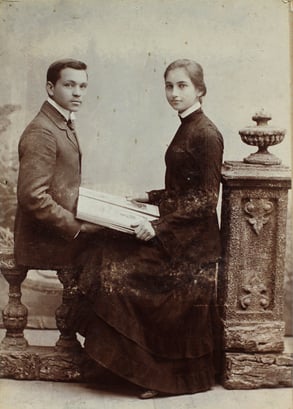
1815 AD – With the destruction of the Napoleonic wars ravaging half the globe, western civilization doubles down on its divided gender roles. It’s decided that women and men must occupy different spheres at all times — men provide and protect, women nurture and support. These two spheres come to be seen as almost sacred and necessary for marriage and society with the Dutch writer Cornelius van Engelen stating that these “separation of powers” be necessary for not only the health of marriage but for the health of society as well.
Because women are no longer necessary for economic means, for the first time in world history they are pursued for emotional purposes. And with these new pursuits comes a new idealization of love and romance. Love had been seen until now as impractical and irresponsible (see: Romeo and Juliet). But now young couples were pursuing love over all economic considerations, making grand declarations about “soul mates” and “destiny” in the process. The older generation shrieks at the younger generation’s lack of values and the inappropriateness of it all.
1825 AD – A side effect of this idealization of love is the complete desexualization of both sexes, but especially women. Since women are now sought for their emotional purity, any hint of female sexuality is considered vulgar and disdainful. Men are expected to suppress all sexual desires and women are told that they don’t even have sexual desires anymore. Married couples are told that sex, even within marriage, is an embarrassment to god and a threat to their emotional union. Even married people don’t get laid anymore.
1877 AD – John Harvey Kellogg — yes, the cereal guy — becomes a national celebrity in the United States by writing about the health hazards of masturbation. Kellogg claims that masturbation leads to blindness, mental breakdowns and even death. He also states that sex is always unhealthy and immoral, even within one’s marriage. He proves his point by staying home and sending his wife away for their honeymoon.
1880 AD – Women increasingly suffer from cases of “hysteria,” an emotional illness unique to women. The cure for hysteria, according to medical textbooks of the time, is to massage a woman’s clitoris until “paroxysm” occurs. Widows and unmarried adult women seem particularly susceptible to hysteria, yet no one knows why.
By the late 1800s, doctors begin to complain of wrist and finger pain from treating so many female patients for hysteria. In 1880, Doctor Joseph Granville invents the first vibrator. His female clientele booms.
1896 AD – An Austrian psychologist by the name of Sigmund Freud invents the practice of psychoanalysis. Freud comes to the conclusion that everyone’s problem is that they’re sexually repressed. Considering how fucked up the period he lived in was, you can’t really blame him.
1920 AD – After multiple decades of being nagged about it, men finally get around to letting women vote.

1928 AD – With booming economies, jazz dance clubs and the newfound freedom of automobiles, men actually begin to take women out on dates. This is the first time in human history that courtship occurs without the woman’s family being involved.
Sexual tension makes a big comeback. Movies, radio and expanded global trade open up people’s eyes to more ideas and opportunities than ever before. Women begin to openly rebel against the established norms of acceptable behavior. They want to drink. They want to dance. And so they do. They take a more casual approach to their sexuality and openly express it — although in measured doses. Domestic abuse goes down. Extramarital affairs go up. Women cut their hair short, smoke cigarettes and dare to show their knees in public. Men become more aggressive, sexually pursuing women whom they have no plans on marrying, since after all, they can finally get laid again. The older generation shrieks at the younger generation’s lack of values and the inappropriateness of it all.
1929 AD – Stock market crashes. Great depression begins. Some wives take jobs to help support their families. Some husbands lose their jobs and are supported by their wives. It gets awkward.
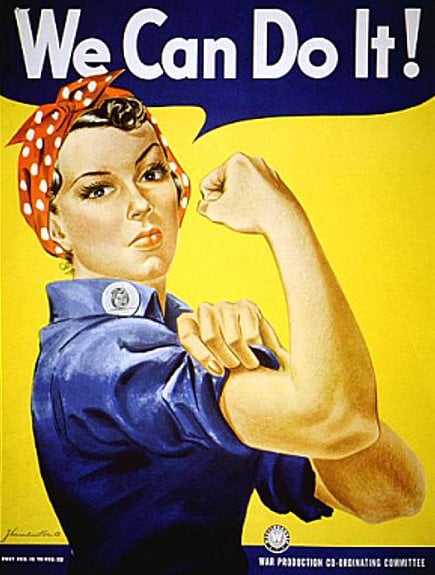
1939 AD – The Second World War begins. Men enlist in the military and women enlist in the factories. Women discover that not only are they good at labor jobs, but some of them kind of like it.
1945 AD – The war ends. Men come home. Everybody is sick and tired of the past two decades of anxiety, poverty and destruction. People just want to play house and make babies. The marriage rate skyrockets. Home ownership as well. Child births too. The baby boom and the idyllic post-war period begin. The economic boom will keep the dream alive for a decade or two, but it will all fall apart soon. The economy was changing and women had learned too much self-sufficiency in the past three decades to remain quiet for long.
1949 AD – Simone de Beauvoir writes The Second Sex and says that being a house wife actually kind of sucks. The book catches on.
1955 AD – “Leave it to Beaver” family life is in full swing. Despite rock bottom divorce rates and idealization decades later as a “golden age” for family values, the 1950s had higher rates of alcoholism, rape, domestic violence, and lower marriage satisfaction than pretty much any of the decades that followed it. Sexual harassment was the norm. As was racial segregation. If anyone talks about this time period like it was some perfect, innocent age, they’re probably either a delusional baby boomer waxing nostalgic, or a conservative crackpot.
1960 AD – The birth control pill is invented. Women are now able to control their own fertility. For the first time ever, women have the option to have strictly recreational sex. In my opinion, this is quietly one of the most important points on this entire list.
1964 AD – A series of new laws promise equal pay and equal employment/education opportunities to women in most western countries.
1967 AD – Free love. Hippy communes. Overrated music. Drugs (lots of drugs). The older generation shrieks at the younger generation’s lack of values and the inappropriateness of it all.
1973 AD – Abortion becomes legal. Lenient divorce laws cause the divorce rate to spike up to 50% as women begin divorcing their husbands en masse.
1980 AD – The first billboard of a scantily clad man appears in Times Square. The male body is now sexualized and objectified in pop culture. Men grow their hair long. Women cut their hair short. Meanwhile, after winning a series of legislative and legal victories over the past two decades, feminism invades academia where they proceed to spend the next 10 years arguing over whether sex is good or bad, whether pornography causes rape, whether biological differences even exist at all, and whether women should just all just move to a remote island and become lesbians together. Men are afraid to say anything.
1981 AD – HIV erupts. Society quickly concludes that yes, sex actually is really bad. Education policy is redesigned to make sure that every child knows this.
1982 AD – More women enroll in college than men for the first time ever.
1991 AD – Western culture hits peak political correctness and it is now offensive to say just about anything about anybody.
1993 AD – The internet shows up in people’s homes. As usual, pornography is one of the primary driving forces behind the new medium.
1994 AD – Attention Deficit Disorder officially hits the DSM-IV and disproportionately high amounts of young boys are diagnosed and medicated for being too hyperactive and inattentive in school. Later, some psychologists dare to argue that this is normal boy behavior and driven by biology.
1995 AD – The famous dating advice book for women, The Rules, is published. The book encourages women to act cold and indifferent towards men to get men to like them more. The book becomes a bestseller.
1998 AD – The hit television show Sex and the City airs. The show portrays the fun and sexy side of being a single, professional woman. The show is quickly criticized for showing the fun and sexy side of being a single, professional woman. Meanwhile, Bill Clinton, like many US presidents before him, gets a blowjob in the White House, and almost loses his job over it.
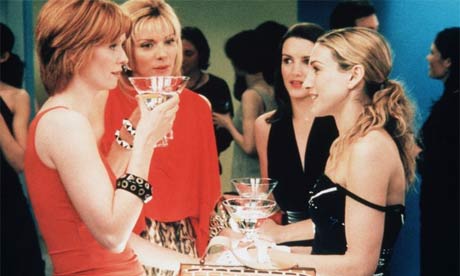
2000 AD – Incidents of rape hit an all-time recorded low with a decline of more than 85% between 1980 and 2000.
2003 AD – Incidents of domestic violence hit an all-time low with a decline of more than 60% between 1993 and 2003.
2004 AD – The HBO show Entourage airs as a male-oriented counterpart to Sex and the City. Entourage shows men that having tons of money, partying with your friends and banging hot girls is cool. Men already knew this.
2005 AD – The famous dating advice book for men, The Game, is published. The book encourages men to act cold and indifferent towards women to get women to like them more. The book becomes a bestseller.
2008 AD – Newfound equality in education and income, combined with readily available contraceptives and lower incidents of rape and sexual violence give rise to “hook up culture,” a practice where young people consciously choose to become sexually active with one another while not investing in an emotional relationship. Surveys find that hook up culture, particularly in young women, arises due to higher priority given to career advancement and education. Despite the fact that teen pregnancies, rape, teen sexual activity, abortions, divorce rate are at their lowest levels in over 30 years, the older generation shrieks at the younger generation’s lack of values and the inappropriateness of it all.
2010 AD – For the first time in history, women make up the majority of the workforce. Women also earn more graduate degrees than men for the first time. Wage gap at lowest levels but still not eliminated entirely.
2011 AD – Over the course of three months, a men’s dating coach writes and self-publishes Models: Attract Women Through Honesty while living abroad in Russia. The book promotes honesty and vulnerability as the roots of healthy and attractive behavior in men. It also differentiates between false displays of confidence and true, genuine, attractive confidence. The book sells tens of thousands of copies with basically no mainstream promotion or marketing. Instead, the author shamelessly promotes himself all over articles such as this one.
2014 AD – Despite the fact that gender equality is likely the best its ever been, sexual and domestic violence are likely the lowest they’ve ever been, and sex education and marriage satisfaction are likely the best they’ve ever been, the constant extremist noise of the internet would make you think that both genders are in the middle of a crisis, if not all-out war.
Gender identity struggles have been ubiquitous throughout history. Men in the 19th century lamented the feminization of boys and angrily reproached women for their sexuality. Books and plays in the 16th century were written advising women to know their place and be obedient to their husband. Women in the 1920s struggled to express themselves and be accepted for their beliefs and not just their bodies. Ancient Greeks lamented that boys were growing up weak and soft due to too much schooling and not enough warfare.
There is nothing special or unique about our identity struggles today. Every generation goes through them in their own way. The solved problems of this generation will spawn the unsolved problems of the next generation and so the cycle will continue.
Further Reading:
- The Red Queen by Matt Ridley
- The Evolution of Human Sexuality by Donald Symons
- Sexual Selection and the Origins of Human Mating Systems by Alan F. Dixson
- Sex at Dawn by Christopher Ryan and Cacilda Jetha
- The Blank Slate: The Modern Denial of Human Nature by Steven Pinker
- Delusions of Gender by Cordelia Fine
- The Myth of Male Power by Warren Farrell
- Manhood in the Making by David Gilmore
- Marriage: A History by Stephanie Coontz
- The End of Men by Hanna Rosin
- Who Stole Feminism? by Christina Hoff Sommers
- Raising Cain by Michael Thompson and Dan Kindlon
- What Do Women Want? by Daniel Bergner
